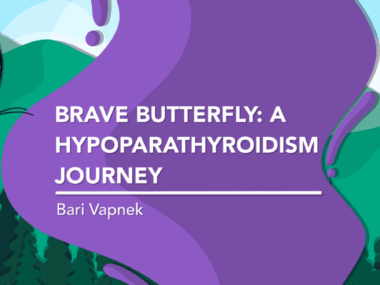Feeling hopeful about the future of hypoparathyroidism treatment
Reflecting on how far we've come
Written by |

“Knowledge is the light of the mind.” — University of Delaware’s motto
May 27, 1995, was a significant day in my life. It was the day I graduated from the University of Delaware, a momentous occasion held at the school’s football stadium in Newark. The hot and sunny Memorial Day weekend was the backdrop for me to proudly receive a bachelor’s degree in science. This achievement, coupled with the lifelong friendships I formed, the knowledge I gained, and the philanthropy I discovered through my sorority, Alpha Epsilon Phi, marked the beginning of a new chapter in my life.
I knew everything would change, but I didn’t yet understand how.
At my graduation, the late Al Neuharth, founder of USA Today, delivered a speech that left a lasting impression on me. “The difference between a mountain and a molehill is your perspective,” he observed.
Though I didn’t realize it at the time, these words would become a guiding light for me as I faced the mountains and molehills that came with my hypoparathyroidism diagnosis just three years later.
How far we’ve come
The University of Delaware boasts a rich history. Three signers of the Declaration of Independence attended its predecessor, a school led by the reverend Francis Alison in New London, Pennsylvania. As one of the oldest universities in the United States, it has celebrated more than 150 commencement ceremonies since 1836. This leads me to contemplate what has changed in that time, particularly in regards to hypoparathyroidism research and treatment.
According to a report published in 1995 in the American Journal of Kidney Diseases, diseases of the parathyroid glands were some of the last to be defined in the field of endocrinology. These glands were first identified in humans in the late 1800s, and it wasn’t until 1908 that scientists suggested certain symptoms could be the result of hypocalcemia (low calcium levels) following the removal of one or more of the parathyroid glands.
For years, the standard treatment for hypoparathyroidism involved supplementation with calcium and activated vitamin D, or calcitriol. Today, patients may be prescribed parathyroid hormone (PTH) replacement therapy in the form of Yorvipath (palopegteriparatide) to help manage blood calcium levels.
PTH is to patients with hypoparathyroidism what insulin is to people with diabetes. It’s essential for enhancing quality of life, maintaining stable blood levels, supporting mental health, and preventing various comorbidities. And with emerging treatments at various stages of development, the evolving landscape of hypoparathyroidism is promising:
- Canvuparatide (MBX 2109) is being developed by MBX Biosciences as a once-weekly PTH replacement therapy. It is currently being studied in a Phase 2 clinical trial.
- In partnership with Calcilytix Therapeutics, Bridgebio Pharma is currently studying encaleret in a Phase 3 trial called CALIBRATE. Encaleret is a potential oral treatment being developed for people with autosomal dominant hypocalcemia type 1, a form of hypoparathyroidism.
- AstraZeneca’s eneboparatide (AZP-3601), an investigational drug designed to mimic PTH, met its primary endpoint in the CALYPSO Phase 3 trial. It is still being studied in adults with chronic hypoparathyroidism.
- A natural history study of adults with hypoparathyroidism, called SHINE, is underway. Researchers are observing long-term complications of the disease to help inform hypopara management.
Reflecting on the past and looking toward the future
I recently watched a fellow alumnus deliver this year’s commencement speech for the University of Delaware. Since then, I’ve been reflecting on how far science has come since 1995, and how I’ve put my education to use, despite my diagnosis.
Commencement speaker Matt O’Donnell, a news anchor for 6ABC in Philadelphia and a graduate of the class of 1994, reminisced about his late nights studying at Morris Library, Thursday night pitchers at Deer Park Tavern, and classes with legendary professors Dennis Jackson, PhD, and Joseph Pika, which brought back fond memories of my incredible four years in Newark. He shared sentiments with the graduates that resonated with me: “And so my advice for you is to be you. If you’re good at something, do it! Find it. Do it. Do it more.”
Three decades after my graduation, I find myself chronicling my experience with hypoparathyroidism. In 1995, I never anticipated that writing would become part of my life’s blueprint. Similar to the advances in hypoparathyroidism, beneficial outcomes require time.
This brave butterfly will continue to be herself and spread her wings of hope, embodying memories, aspirations for the future, and the understanding that it is never too late to discover our true potential. Especially with these new PTH drugs in development, there’s hope and promise for the future.
I thank Neuharth and O’Donnell for inspiring me to change my perspective on adversity and obstacles. Their words perfectly describe my hypoparathyroidism journey. I am happy to be part of this change and to share my experience with you.
Note: Hypoparathyroidism News is strictly a news and information website about the disease. It does not provide medical advice, diagnosis, or treatment. This content is not intended to be a substitute for professional medical advice, diagnosis, or treatment. Always seek the advice of your physician or another qualified health provider with any questions you may have regarding a medical condition. Never disregard professional medical advice or delay in seeking it because of something you have read on this website. The opinions expressed in this column are not those of Hypoparathyroidism News or its parent company, Bionews, and are intended to spark discussion about issues pertaining to hypoparathyroidism.







Marcia Gordon
Can’t believe it’s been 30 years since you graduated from U of Delaware. Your articles are so informative and inspiring! Thanks for making the world aware of hypoparathyroidiism.